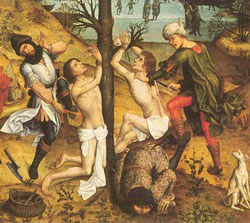
Feastday: October 25
Unreliable legend had Crispin and Crispinian, noble Roman brothers who with St. Quintinus, went to Gaul to preach the gospel and settled at Soissons. They were most successful in convert work during the day and worked as shoemakers at night. By order of Emperor Maximian, who was visiting in Gaul, they were haled before Rictiovarus (whose position is unknown and even his existence is doubted by scholars), a hater of Christians, who subjected them to torture; when unsuccessful in trying to kill them, he committed suicide whereupon Maximian had the two brothers beheaded. They are the patrons of shoemakers, cobblers, and leatherworkers. Their feast day is October 25th.
3rd-century Christian martyrs and saints This article is about the Christian saint. For other uses of Crispin, see Crispin (disambiguation).| This article needs additional citations for verification. (December 2016) |
Saints Crispin and Crispinian are the Christian patron saints of cobblers, curriers, tanners, and leather workers. They were beheaded during the reign of Diocletian; the date of their execution is given as 25 October 285 or 286.
History
Born to a noble Roman family in the 3rd century AD, Crispin and Crispinian fled persecution for their faith, ending up at Soissons, where they preached Christianity to the Gauls while making shoes by night. It is stated that they were twin brothers.
They earned enough by their trade to support themselves and also to aid the poor. Their success attracted the ire of Rictus Varus, governor of Belgic Gaul, who had them tortured and thrown into the river with millstones around their necks. Though they survived, they were beheaded by the Emperor c. 285–286.
A 16th century legend links them to the town of Faversham.
Veneration
The feast day of Saints Crispin and Crispinian is 25 October. Although this feast was removed from the Roman Catholic Church's universal liturgical calendar following the Second Vatican Council, the two saints are still commemorated on that day in the most recent edition of the Roman Church's martyrology.
In the sixth century, a stately basilica was erected at Soissons over these saints' graves, and St. Eligius, a famous goldsmith, made a costly shrine for the head of St. Crispinian.
They are the patron saints of cobblers, glove makers, lace makers, lace workers, leather workers, saddle makers, saddlers, shoemakers, tanners, and weavers.
Crispin and Crispinian are remembered in the Church of England with a commemoration on 25 October.
Cultural references
The Battle of Agincourt was fought on Saint Crispin's feastday. Shakespeare's St. Crispin's Day Speech (sometimes called the "Band Of Brothers" Speech) from his play Henry V has immortalized it. Also, for the Midsummer's Day Festival in the third act of Die Meistersinger, Wagner has the shoemakers' guild enter singing a song of praise to St. Crispin.
A plaque at Faversham commemorates their association with the town. They are also celebrated in the name of the old pub "Crispin and Crispianus" at Strood.





